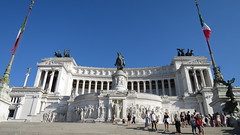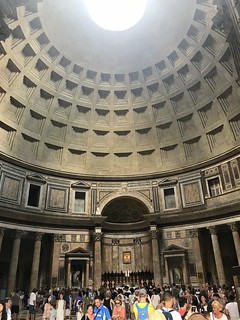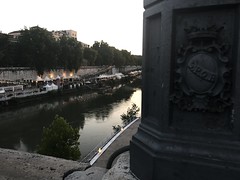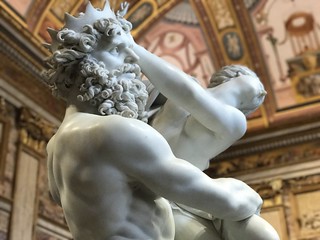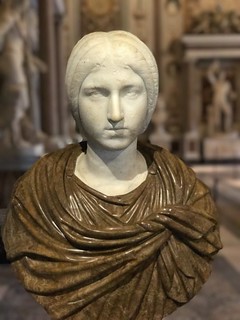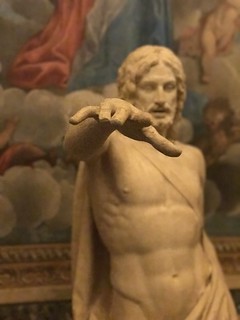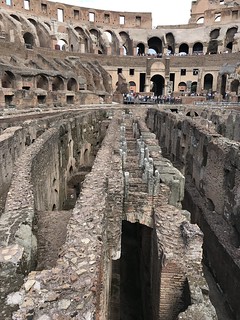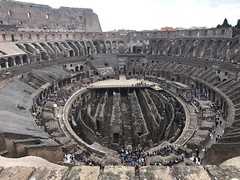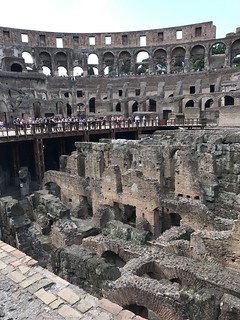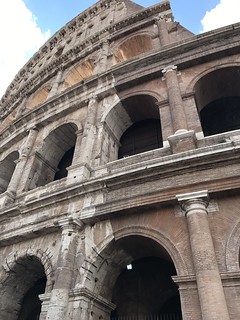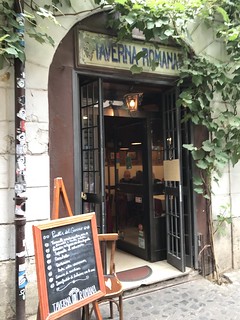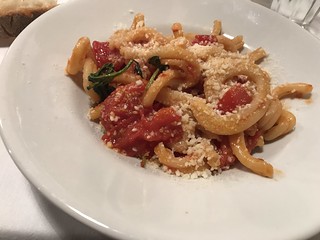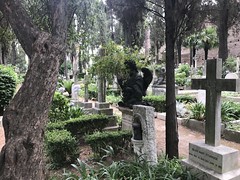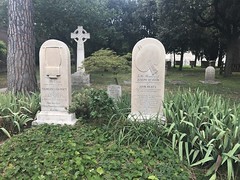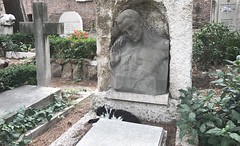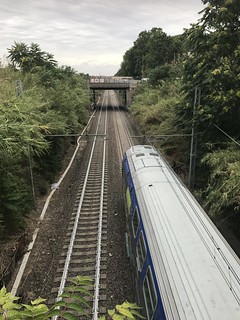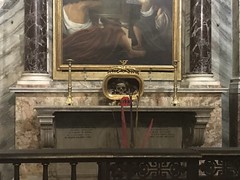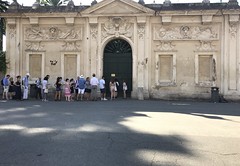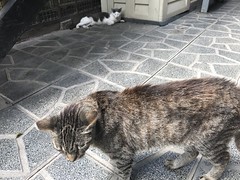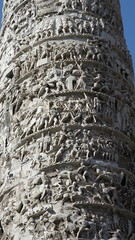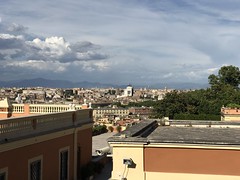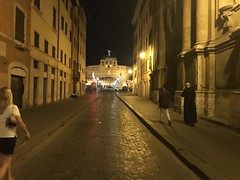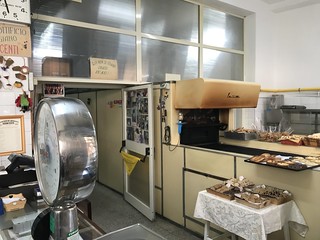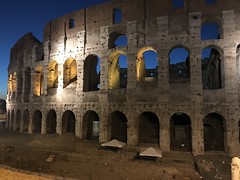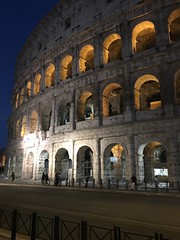
From Florence I took a high speed train to Rome in late June. I stayed at a small Airbnb loft near Palatine Hill, the Colosseum, Circus Maximus, and many other historic locations.
Since I was a kid I’d been fascinated by Rome, a small city that somehow became a vast empire through technological superiority and military might. Today it’s a bustling city with an unusual mixture of history and modernity on nearly every corner. Although I also had a sillier reason to visit; more on that in a bit.
Not long after arriving in Rome I was joined my Greek friend and his girlfriend for the first part of the trip; I joined them again in Greece, which I’ll get to in a subsequent post.
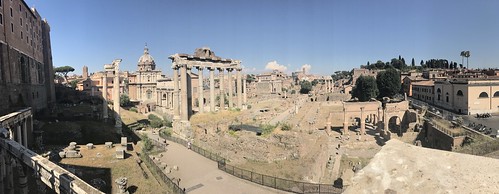
Google Maps had somewhat screwy walking directions near the Airbnb. As it happened, the Airbnb was steps away from a number of other historic sites including Rome’s Tomb of the Unknown Soldier (locals jeeringly call this the “wedding cake”) and the Basilica of Santa Maria in Ara Coeli church. Both are built on top of a partially excavated site adjacent to Palatine Hill.
Today Italians refer to this weird mix of structures from various eras as “architectural lasagna,” a theme that’s especially present in Rome.
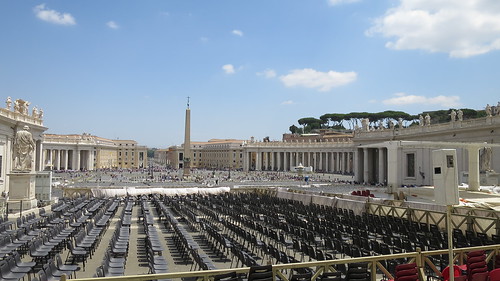
The three of us went to the Vatican on a guided tour. You can’t talk about Rome without discussing Vatican City. Technically it’s a separate country from Italy with its own governance, but no sane government would allow so many people into such tight quarters. The Vatican apparently doesn’t believe in fire codes. Seriously, the place is not only a tourist trap, it’s a potential fire trap as well.
My tour group wasn’t alone in being rushed through one tight room after another, finally going through a densely crowded Sistine Chapel. Is it Michelangelo’s most impressive work? I couldn’t tell you, as Vatican security yelled at everyone to keep moving so fast that I barely caught a glimpse of it. My takeaway here is that the Vatican is not worth visiting, it’s just another overcrowded tourist trap. Unless you can arrange for an off-hours visit, skip the Vatican; there are many more pleasant places to visit in Rome.
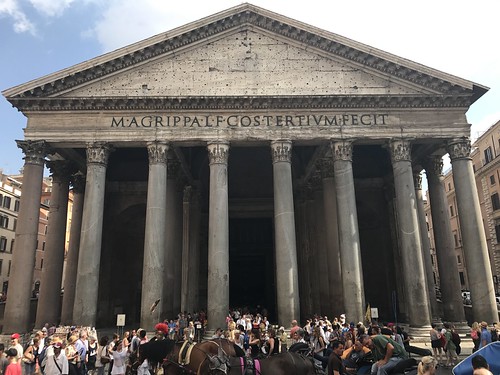
One of the oldest Roman buildings still standing is the Pantheon, a temple built with a non-reinforced concrete dome. These days it’s a church and is free to enter — and is well worth visiting. If nothing else the structure is an outstanding example of ancient architecture which still survives to this very day.
Here I should point out that Rome had an unusual history of flooding. For centuries, Rome had floods that brought more and more sediment, bringing the street level slightly higher after each flood. For this reason the Pantheon — like many excavated structures below Palatine Hill — sits below today’s street level, evidenced by trenches around the structure.
Around this time we started making regular visits to Trastevere, a hipster foodie mecca on the east side of the Tiber river. We visited a few excellent restaurants, my favorite of which was La Boccaccia, a Roman-style pizza joint. If you’re unfamiliar with Roman pizza it’s a relatively thin, flat pizza made in rectangular pans and served in rectangular slices. The comparison to Little Little Ceasars is obvious, but a good Roman pizza is much thinner and has a variety of delicious, high quality toppings.
Later in the trip I ventured out to a food tasting trip in Trastevere which I’ll cover shortly.
Down at the level of the Tiber was a film festival on Tiber Island, with a variety of shops and activities on either side of the riverbank across from the island, mostly in white tents. The funniest of which was a roller coaster simulator that involved moving chairs with Oculus Rift headsets. This festival was particularly active during the evening.
The following day the three of us arrived slightly late to our appointment at the Galleria Borghese, an art museum focusing on the sculptures of Gian Lorenzo Bernini, a few of his contemporaries, and paintings from Caravaggio and others from the same late-Renaissance era.
It’s a small but remarkably well organized museum. I was particularly impressed by the sculptures. The first of the photos above depicts David in a battle-ready and clothed position, quite different than how Michelangelo had portrayed him earlier.
The Galleria Borghese is located inside a park called Villa Borghese Gardens, which is just outside the historic city wall of Rome. Unfortunately we didn’t get to explore the park due to an unexpected rain storm.
This museum has an unusual appointment system that I should probably explain here. Unlike most museums where you can stay as long as you like during the open hours, the Borghese requires visitors to book an hour long visit. You can come and go freely during that time, but when it’s over everyone has to leave so the next group can come in. The last ten or so minutes a loud breathing sound effect is played throughout the gallery, alerting visitors that their time is almost up. (Immersive designers may be interested in this fusion of modern technology with old-fashioned artwork to evoke a sense of creeping urgency.)
An hour was about the right amount of time in this museum; we went with the official English-language tour that covered the most important works, which only lasted about the first half of our booked hour.
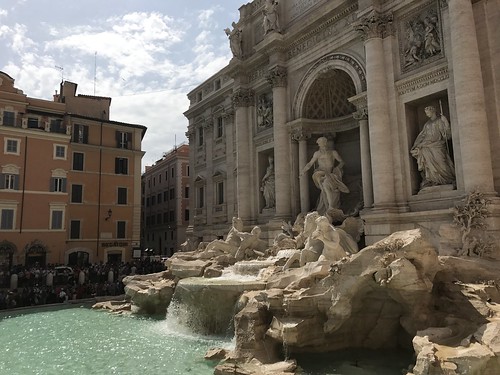
From there we visited the Trevi Fountain, a beautiful 18th century fountain that’s a tourist magnet. Like many sites in Rome it was heavily policed. By this point in the trip I was pretty much done shoving my way through crowds — if you visit during tourist season I’d recommend going at night when it’s less crowded.
The same evening we went on a tour of the Capuchin Crypt, a display of human bones from the Capuchin Monks in the basement of one of their churches. The tour included a bus trip just outside of Rome’s historic walls to an early Christian catacomb, which was after hours and as such an uncrowded a peaceful relief from the heat. It was also a hiding spot for Allied soldiers during both world wars, who left behind graffiti. Unfortunately, photos were prohibited at both sites.

The following day our time together in Rome came to a close, but not before a tour of the Colosseum and Palatine Hill. Although this tour was ostensibly through Walks of Italy, for the majority of the Colosseum tour our group was merged with other tours for an official Colosseum tour, which includes the underground, the nosebleed section, and a few unusual spots like the bathrooms and the elevators from the underground to the arena floor.
The Colosseum’s exterior has been power-washed recently to remove blackened exhaust reside, but it’s still visible in the interior. Private cars are no longer allowed on the road outside the entrance to the Colosseum — but there’s a Metro station there, and a second Metro station was under construction for a new line.
Palatine Hill and the area just underneath were interesting, although much of the structures that once adorned it are now in ruins. A church and the former Senate Hall still stand just below the hill, as do a number of triumphant arches (at least three?) I should point out that you can get a combined official ticket to both the Colosseum and Palatine Hill without a tour.
Just after the tour we headed to Taverna Romana for lunch on the recommendation of our guide. This turned out to be one of the better places in the ultra-touristy neighborhood of Monti, with almost everything made in house, including pasta and deserts. Surprisingly, the prices were very reasonable.
A few hours later my friends headed to the airport and flew back to Athens, and I was on my own again for the next six days.
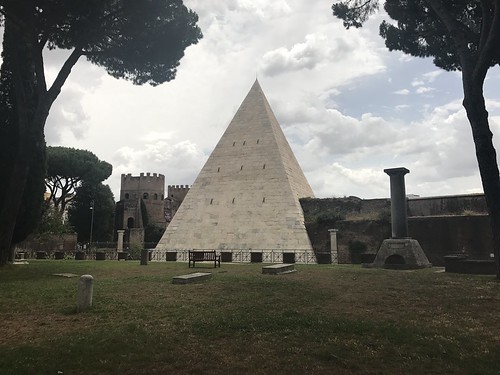
The following morning I took a long and meandering walk to see the pyramid in Rome. Yes, that’s right — there’s a pyramid in Rome, albeit a small one. It’s located in the “non-Catholic” cemetery which is also the resting place of two Romantic-era English poets, Shelley and Keats, among many other people.
It’s still an active and well maintained cemetery with beautiful gardens, but also serves as a cat sanctuary. While most of the cats were young and skittish, one big fat friendly calico cat resting on top of a large gravestone meowed at me, so I went to pet him. Five minutes later I found myself covered in cat hair and regretted not bringing along a lint roller to clean off my clothes. Thankfully, the cemetery also has a free bathroom with paper towels.
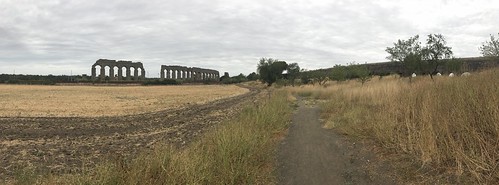
From the cemetery I walked over to the “Piramide” Metro station nearby and rode the to the Park of the Aqueducts, a public park somewhat off the beaten path that contains ruins of the Roman Aqueducts. The surrounding area is decidedly non-touristy, and not everyone in the area necessarily speaks a word of English. This was only slightly problematic when finding a quick bite for lunch.
The park itself is a somewhat rural mishmash between the various historical aqueducts — at least two that I spotted — as well as picnic areas, day care centers, and fenced off areas for various train systems. Despite being near-peak tourist season the park was largely deserted, aside from a few locals going for a jog or having lunch. I was disappointed though not surprised to find the oldest aqueducts heavily covered in graffiti.
Walking to the Metro station on the other end of the park I got a little lost, and heard sheep baaing in the distance. A sign pointed to a ranch somewhere inside the park but I never managed to find the animals. On my way to the Metro, Google Maps led me through a small neighborhood, took me on a pedestrian and bike path under a rail bridge, and around some apartments. Though I found the aqueducts fascinating to see up close I also felt glad to be back in modernity. Rome’s ancient past is somehow still very much alive and well to this day alongside its urban counterpart. For those interested in Roman history I’d recommend this park, and even if you’re only mildly interested the place is surreal enough I think most visitors would at least find it intriguing.
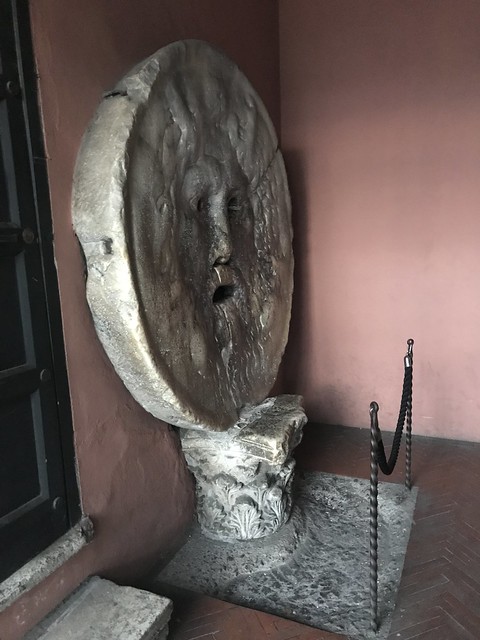
In the morning I went on a free walking tour that included a number of interesting sites, including the legendary Mouth of Truth, the alleged skull of St. Valentine, and the Aventine Keyhole, the later of which is the above photo of all the people waiting in line to see it. Despite my best efforts I couldn’t get a decent photo through the keyhole, but you can easily find photos on Google Images.
I happened to mention to the tour guide that I’d seen a version of the Mouth of Truth that’s a fortune telling machine at home in San Francisco. He theorized that these fortune telling machines were all over and were part of the appeal of seeing the real thing. But he also pointed out something else we had a replica of in San Francisco…
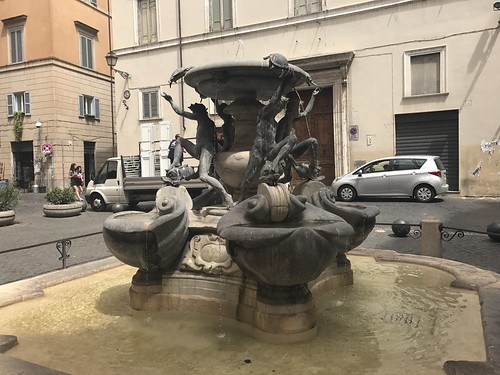
Does the above fountain look familiar to you? If you’ve been to the park on top of Nob Hill in San Francisco, it should — because it’s a replica of this original one in Rome. Located in a small square in the Jewish Ghetto, the original Turtle Fountain was built during the Renaissance. Oddly, the turtles by which its known weren’t originally part of the fountain, but were added decades later.
For lunch I stopped by the nearby Pizza Florida, another excellent by-the-slice Roman pizza joint that I’d recommend almost as much as La Boccaccia. Across the street there’s an excavation site which was once the Largo di Torre Argentina temples, notably the place where Julius Caesar was assassinated. Today one corner is accessible and operates as a cat shelter.
After a long walk in what was becoming unbearable heat, I found one of the silly things I knew I had to see in Rome — Via Ezio. See, it wasn’t exactly a coincidence I visited three of the cities in Assassins’ Creed II (one of my favorite video games of all time) which stars a character named Ezio Auditore. Seeing places I’d only visited virtually in the real world, albeit a few hundred years after the events of the game were to have taken place, was part of the Italian leg of this trip’s appeal. Some of it felt downright uncanny. So I had to make an out of the way pilgrimage to a short street that happened to share the name of the main character.
The next day I wandered over to a fast casual restaurant near the Colosseum called “Avocado Bar” and ordered their avocado toast for brunch. When in Rome… amirite? It was great and unexpectedly filling, with a layer of beets under the avocado and topped with nuts.
After lunch I headed to my appointment at the “Domus Romane di Palazzo Valentini,” a multimedia museum located in the basement of a (relatively) modern building. The basement was excavated by archaeologists who found two layers of history; a series of Renaissance era structures on top of a couple of mansions from the Roman Empire. A surprising amount of the mansions remains intact, from various rooms to tile patterns on the floor.
While visiting this site, you’re mostly looking down through a glass floor, with lights and projection-mapped visuals timed to an audio guide explaining what you’re looking at. In some cases the projection mappings visualize what archaeologists imagine how the original buildings appeared. At the end of the tour there’s a video explaining Trajan’s Column, a monolith just outside the museum which tells the story of a Roman battle.
Photography isn’t allowed anywhere inside Domus Romane di Palazzo Valentini, but you can get a good idea of what it looks like from their website. Personally I enjoyed this one, it’s a creative and modern way to peek into history.
Not having learned my lesson from the ultra long walk through Aqueduct Park, I decided to take another epic stroll through Trastevere to a hill that’s either spelled “Janiculum” or “Gianicolo” depending who you ask. The way up the hill isn’t obvious, and I somehow managed to take a route that was partially fenced off due to construction. Oops. Anyway, at the top I found a giant church, which was hosting a wedding at the time. Rather than crash the wedding — which I wasn’t dressed for anyhow — I continued on and found an enormous fountain as well as some other recreational structures, part of a park on the hilltop. It also features spectacular views of Rome.
It’s not difficult to find an amazing view in Rome, but this one has many vantage points and is completely free. When I went the hilltop had thinner crowds than other touristy spots in Rome.
After heading back down the hill I went to La Boccaccia again for some more pizza, because hey, I was already in Trastevere and who can resist a perfect slice of pizza? Not me, apparently.

The next morning I went to visit the ruins of the Baths of Caracalla, an enormous bathhouse from the days when Rome’s power was at its peak. Today it’s used mostly as the backdrop for a series of outdoor operas. The building is surprisingly well intact considering it hasn’t been used since AD 500 or so, including original tile floors, and has been exposed to the elements for most of that period.
But the real draw for me was in the basement level, which was once a Mithraic temple. They tended to be in basements and there are many in Rome, but most are closed to the public. This one’s free, although none of the original artifacts are still down there. The audio guide available at the baths goes into this a little, but as much as I would have liked.

In the evening I took a walking tour that visits allegedly haunted locations. The tour features some brutal subjects including a heretical monk roasted alive over a spit fire and women poisoning their husbands to avoid divorce.
Like any modern city, Rome has its own modern ghost stories too — one of them involves the filming of a recent James Bond movie. Be warned that this tour can go late.
On my final day in Rome I took a late afternoon food tour in the Trastevere neighborhood. We stopped at a small restaurant for light appetizers, then an old synagogue basement now used as a wine cellar (left photo above) for a wine tasting and more appetizers, a deli where we tried various small items, an excellent pastry shop (right photo above), a tiny “street food” restaurant that served fried cheese balls, a freshly-made pasta restaurant, and finally a gelato joint for desert.
As a non-meat eater they made special arrangements for me at a few locations, though for the most part I had the same food as everyone else. I was completely stuffed at the end and ready to call it a night.
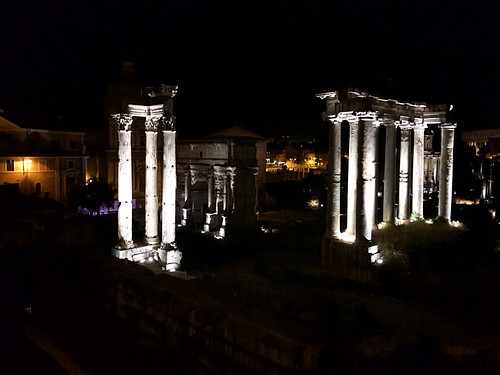
The above photos aren’t connected to anything, I just thought it would be fun to end on some photos of Rome at night. It’s a scenic city after dark — although I bet it wasn’t before electric lighting came along.
So to wrap this all up (is anyone still reading this post?) here’s a list of all the tours I went on in Rome:
- Vatican Tour from Dark Rome/CityWonders. Maybe this is better in the off season, but I’d stay away if I were you. Other tour operators aren’t going to be any better, the crowds were the real issue.
- Galleria Borghese. You have to book this one in advance and you only get to stay for an hour. We did the guided tour, which doesn’t take the full hour. It’s much more tastefully presented than anything you’d see in the Vatican.
- The Crypts & Catacombs at Night: With Exclusive After Hour Access from Walks of Italy. More than a little morbid, but that’s all part of the appeal. No real crowds to contend with since it’s after hours.
- Walks of Italy’s VIP Colosseum Underground Tour with Roman Forum & Palatine Hill. This one felt both rushed and too long at the same time. I’d recommend booking the Colosseum and Palatine Hill separately if possible.
- The free walking tour from Veni Vidi Visit isn’t the only free walking tour in Rome, but it included somewhat more esoteric stops that I was more interested in seeing. Bring a cash tip if you go.
- Domus Romane di Palazzo Valentini, the multimedia archeology exhibit. Definitely go, and definitely book way in advance.
- Baths of Caracalla’s audio guide tour. Not sure if there’s an official website for this one, but it doesn’t matter. It’s pretty easy to find, relatively cheap, and if you pay slightly extra for the audio guide you can go around looking at the ruins instead of reading text in small print on the signs scattered around the place.
- The spooky story Dark Heart of Rome tour from City Wonders is fun — if you’re into that sort of thing. This one involved more walking than the others.
- Twilight Trastevere Food Tour from Eating Italy. This one fills up fast, which is why I had to go in the afternoon, so book it in advance if possible. It’s great if you like Italian food — I wish I’d gone on their sister tour in Florence.
The remaining photos I took in Rome can be found in this Flickr album.
Come back next time when I complete the Eurotrip 2017 series with my visit to Athens and a handful of Greek islands.


